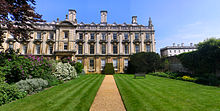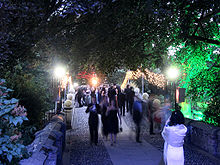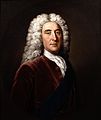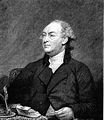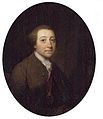- Clare College, Cambridge
-
Colleges of the University of Cambridge
Clare College
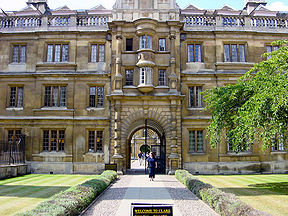
Named after Elizabeth de Clare Established 1326 Previously named University Hall (1326-1338)
Clare Hall (1338-1856)Admittance Men and women Master Prof. Tony Badger Undergraduates 440 Graduates 210 Sister colleges Oriel College, Oxford
St Hugh's College, OxfordLocation Trinity Lane (map) 
College website Boat Club website Clare College is a constituent college of the University of Cambridge in Cambridge, England.
The college was founded in 1326, making it the second-oldest surviving college of the University after Peterhouse. Clare is famous for its chapel choir and for its gardens on "the Backs" (the back of the colleges that overlook the River Cam). The current Master is Tony Badger, Paul Mellon Professor of American History.
Clare is consistently one of the most popular Cambridge colleges amongst prospective applicants.[1] As of 2009, it had an endowment of around £50m.[2]
Contents
History
The college was founded in 1326 by the university's Chancellor, Richard de Badew, and was originally named University Hall. Providing maintenance for only two fellows, it soon hit financial hardship. In 1338, the college was refounded as Clare Hall by an endowment from Elizabeth de Clare, a granddaughter of Edward I, which provided for twenty fellows and ten students.[3] The college was known as Clare Hall until 1856, when it changed its name to "Clare College". (A new "Clare Hall" was founded by Clare College as an exclusively postgraduate institution in 1966.)
Clare's Old Court, a Grade I listed building, frames King's College Chapel as the left border of one of the most celebrated architectural vistas in England. It was built between 1638 and 1715, with a long interruption for the English Civil War. The period spans the arrival of true classicism into the mainstream of British architecture, such that its progress can be traced in the marked differences between the oldest wing to the north, which still has vaulting and other features in the unbroken tradition of English Gothic, and the final southern block, which shows a fully articulated classic style. The college's chapel was built in 1763 and designed by Sir James Burrough, the Master of neighbouring Caius College.[citation needed] Its altarpiece is Annunciation by Cipriani.
Clare has a much-photographed bridge over the river which is the oldest of Cambridge's current bridges. Fourteen stone balls decorate it, one of which has a missing section. A number of apocryphal stories circulate concerning this - the one most commonly cited by members of college is that the original builder of the bridge was not paid the full amount for his work and so removed the segment to balance the difference in payment. A more likely explanation is that a wedge of stone cemented into the ball as part of a repair job became loose and fell out into the river.
Clare's bridge connects Old Court to Memorial Court, which was designed by Giles Gilbert Scott and dedicated in 1926. A new court, Lerner Court, was opened in January 2009.
College life
Clare is known as a liberal and progressive college. In 1972 it became one of the three male Cambridge colleges that led the way in admitting female undergraduates. Clare continues in this tradition and has won praise for the transparency of its admissions process.[4]
Clare is known as one of the most musical colleges in Cambridge. Its choir is internationally recognised and has performed all over the world. Many Clare students play instruments, and the college orchestra (Clare College Music Society (CCMS)) is well known. Like most Cambridge colleges, Clare allows students to have a piano in their college rooms. Clare holds popular jazz and drum'n'bass nights in its cellars.
Clareification
Clare's student newspaper, Clareification, won "Best University College Paper" in "The Cambridge Student" in 2005. Published by the Union of Clare Students, it comprises satirical articles mocking Cambridge traditions, reports on silly student antics, and college gossip in the "Clareifornication" column. It is often the subject of criticism by some staff for risqué and tasteless content, and was described by the Master, Professor Badger, as "an unholy cross between the Sun and Private Eye". On February 3, 2007, the college cut its funding to the paper following the publication of the guest-edited February 2 edition, retitled "Crucification". In addition to the paper's usual satirical attacks on Christianity, this edition also featured several articles which mocked Islam, and a reproduction of the cartoon illustrations of the prophet Mohammed which provoked international protest when they first appeared in Danish newspaper Jyllands-Posten in September 2005.
Academic performance
The undergraduates of Clare College have usually performed very well based on the results published in the Tompkins Table, placing Clare within the top ten colleges from 2000 to 2005.[5] However, their performance in the following years (2006-9) demonstrated a poorer performance, leaving them in 12th in 2006 and dropping to 18th in 2009. Their 2010 performance (8th position) however showed an increase of 10 places over their previous years performance, and in 2011 they reached fourth place.[6]
Entrance into Clare College is very competitive. Overall, Clare has approximately 5 applicants per place. Yet the high quality of applicants means that many of them are awarded places at other colleges through the Winter Pool. Of applicants in 2007, 151 were given offers by Clare, and a further 75 applicants were made offers at other Cambridge colleges.[7]
Famous or notable alumni
Main article: List of Clare College peopleSee also
- List of Clare College people
- List of Masters of Clare College, Cambridge
- Category:Alumni of Clare College, Cambridge
- Category:Fellows of Clare College, Cambridge
References
- ^ College applications and admissions statistics
- ^ Clare's Endowment (updated May 2009)
- ^ 'The colleges and halls: Clare College', A History of the County of Cambridge and the Isle of Ely: Volume 3: The City and University of Cambridge (1959), pp. 340-346. Date Accessed: 2 June 2010
- ^ The pick of the bunch, EducationGuardian, 2005-12-20
- ^ "Tompkins Table 2000-2007". mattmayer.com. http://www.mattmayer.com/fun/tompkins/.
- ^ Tompkins Table 2011 in The Independent
- ^ "Clare Statistics". Clare College, Cambridge. http://www.clare.cam.ac.uk/admissions/statistics.html.
External links
- Clare College, Cambridge official website
- Choir of Clare College, Cambridge official website
- Union of Clare Students (JCR) website
- Clare MCR website
- Clare College Conferencing, Events, Accommodation and Dining
University of Cambridge 
Chancellor: The Lord Sainsbury of Turville (list) · Vice-Chancellor: Sir Leszek Borysiewicz (list)
Colleges: Christ’s • Churchill • Clare • Clare Hall • Corpus Christi • Darwin • Downing • Emmanuel • Fitzwilliam • Girton • Gonville and Caius • Homerton • Hughes Hall • Jesus • King’s • Lucy Cavendish • Magdalene • Murray Edwards (New Hall) • Newnham • Pembroke • Peterhouse • Queens’ • Robinson • St Catharine’s • St Edmund’s • St John’s • Selwyn • Sidney Sussex • Trinity • Trinity Hall • Wolfson
Categories: University • Chancellors • Vice-Chancellors • Colleges • Heads of Colleges • Departments • Academics • Alumni • Awards and Prizes
Websites: University • Students’ Union • Graduate Union

Coordinates: 52°12′18.3″N 0°6′54.7″E / 52.205083°N 0.115194°E
Categories:- Colleges of the University of Cambridge
- 1326 establishments in England
- Educational institutions established in the 14th century
- Clare College, Cambridge
- Grade I listed buildings in Cambridgeshire
- Grade I listed educational buildings
Wikimedia Foundation. 2010.



